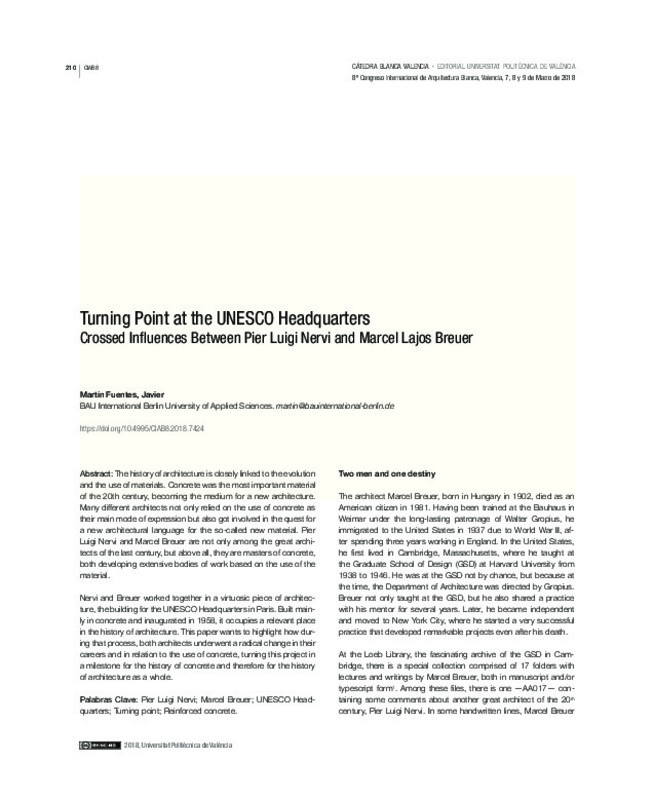JavaScript is disabled for your browser. Some features of this site may not work without it.
Buscar en RiuNet
Listar
Mi cuenta
Estadísticas
Ayuda RiuNet
Admin. UPV
Turning Point at the UNESCO Headquarters. Crossed Influences between Pier Luigi Nervi and Marcel Lajos Breuer
Mostrar el registro sencillo del ítem
Ficheros en el ítem
| dc.contributor.author | Martín Fuentes, Javier
|
es_ES |
| dc.date.accessioned | 2018-09-19T09:44:51Z | |
| dc.date.available | 2018-09-19T09:44:51Z | |
| dc.date.issued | 2018-02-27 | |
| dc.identifier.isbn | 9788490486870 | |
| dc.identifier.issn | 2695-7884 | |
| dc.identifier.uri | http://hdl.handle.net/10251/107742 | |
| dc.description.abstract | [EN] The history of architecture is closely linked to the evolution and the use of materials. Concrete was the most important material of the 20th century, becoming the medium for a new architecture. Many different architects not only relied on the use of concrete as their main mode of expression but also got involved in the quest for a new architectural language for the so-called new material. Pier Luigi Nervi and Marcel Breuer are not only among the great architects of the last century, but above all, they are masters of concrete, both developing extensive bodies of work based on the use of the material. Nervi and Breuer worked together in a virtuosic piece of architecture, the building for the UNESCO Headquarters in Paris. Built mainly in concrete and inaugurated in 1958, it occupies a relevant place in the history of architecture. This paper wants to highlight how during that process, both architects underwent a radical change in their careers and in relation to the use of concrete, turning this project in a milestone for the history of architecture as a whole. | es_ES |
| dc.format.extent | 10 | es_ES |
| dc.language | Inglés | es_ES |
| dc.publisher | Editorial Universitat Politècnica de València | es_ES |
| dc.relation.ispartof | CIAB 8. VIII Congreso Internacional de arquitectura blanca | es_ES |
| dc.rights | Reconocimiento - No comercial - Sin obra derivada (by-nc-nd) | es_ES |
| dc.subject | Hormigón visto | es_ES |
| dc.subject | Arquitectura | es_ES |
| dc.subject | Exposed concrete | es_ES |
| dc.subject | Architecture | es_ES |
| dc.subject | Pier Luigi Nervi | es_ES |
| dc.subject | Marcel Breuer | es_ES |
| dc.subject | UNESCO headquarters | es_ES |
| dc.subject | Turning point | es_ES |
| dc.subject | Reinforced concrete | es_ES |
| dc.title | Turning Point at the UNESCO Headquarters. Crossed Influences between Pier Luigi Nervi and Marcel Lajos Breuer | es_ES |
| dc.type | Capítulo de libro | es_ES |
| dc.type | Comunicación en congreso | es_ES |
| dc.identifier.doi | 10.4995/CIAB8.2018.7424 | |
| dc.rights.accessRights | Abierto | es_ES |
| dc.description.bibliographicCitation | Martín Fuentes, J. (2018). Turning Point at the UNESCO Headquarters. Crossed Influences between Pier Luigi Nervi and Marcel Lajos Breuer. En CIAB 8. VIII Congreso Internacional de arquitectura blanca. Editorial Universitat Politècnica de València. 210-219. https://doi.org/10.4995/CIAB8.2018.7424 | es_ES |
| dc.description.accrualMethod | OCS | es_ES |
| dc.relation.conferencename | 8º Congreso Internacional de Arquitectura Blanca - CIAB 8 | es_ES |
| dc.relation.conferencedate | Marzo 07-09,2018 | es_ES |
| dc.relation.conferenceplace | Valencia, Spain | es_ES |
| dc.relation.publisherversion | http://ocs.editorial.upv.es/index.php/CIAB/CIAB8/paper/view/7424 | es_ES |
| dc.description.upvformatpinicio | 210 | es_ES |
| dc.description.upvformatpfin | 219 | es_ES |
| dc.type.version | info:eu-repo/semantics/publishedVersion | es_ES |
| dc.relation.pasarela | OCS\7424 | es_ES |








